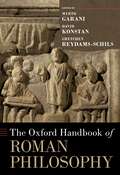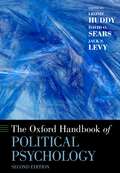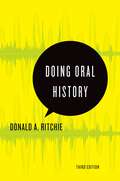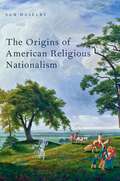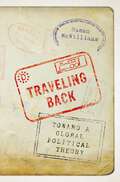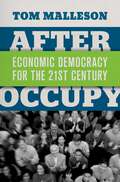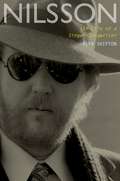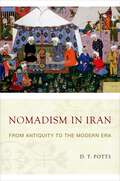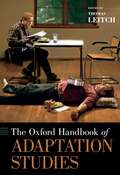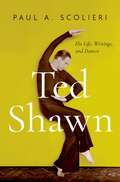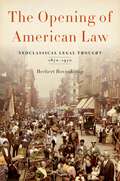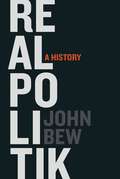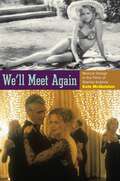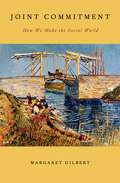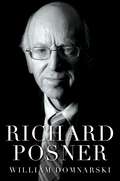- Table View
- List View
The Oxford Handbook of Early China (Oxford Handbooks)
The Oxford Handbook on Early China brings 30 scholars together to cover early China from the Neolithic through Warring States periods (ca 5000-500BCE). The study is chronological and incorporates a multidisciplinary approach, covering topics from archaeology, anthropology, art history, architecture, music, and metallurgy, to literature, religion, paleography, cosmology, religion, prehistory, and history.
The Oxford Handbook of Roman Philosophy (OXFORD HANDBOOKS SERIES)
Several decades of scholarship have demonstrated that Roman thinkers developed in new and stimulating directions the systems of thought they inherited from the Greeks, and that, taken together, they offer many perspectives that are of philosophical interest in their own right. The Oxford Handbook of Roman Philosophy explores a range of such Roman philosophical perspectives through thirty-four newly commissioned essays. Where Roman philosophy has long been considered a mere extension of Hellenistic systems of thought, this volume moves beyond the search for sources and parallels and situates Roman philosophy in its distinctive cultural context. The Oxford Handbook of Roman Philosophy emphasizes four features of Roman philosophy: aspects of translation, social context, philosophical import, and literary style. The authors adopt an inclusive approach, treating not just systematic thinkers such as Cicero and Augustine, but also poets and historians. Topics covered include ethnicity, cultural identity, literary originality, the environment, Roman philosophical figures, epistemology, and ethics.
The Oxford Handbook of Political Psychology: Second Edition (Oxford Handbooks)
Political psychology applies what is known about human psychology to the study of politics. It examines how people reach political decisions on topics such as voting, party identification, and political attitudes as well as how leaders mediate political conflicts and make foreign policy decisions. The Oxford Handbook of Political Psychology gathers together a distinguished group of scholars from around the world to shed light on these vital questions. Focusing first on political psychology at the individual level (attitudes, values, decision-making, ideology, personality) and then moving to the collective (group identity, mass mobilization, political violence), this fully interdisciplinary volume covers models of the mass public and political elites and addresses both domestic issues and foreign policy. Now with new material providing an up-to-date account of cutting-edge research within both psychology and political science, this is an essential reference for scholars and students interested in the intersection of the two fields.
Doing Oral History (Oxford Oral History Series)
by Donald A. RitchieDoing Oral History is considered the premier guidebook to oral history, used by professional oral historians, public historians, archivists, and genealogists as a core text in college courses and throughout the public history community. Over the past decades, the development of digital audio and video recording technology has continued to alter the practice of oral history, making it even easier to produce quality recordings and to disseminate them on the Internet. This basic manual offers detailed advice on setting up an oral history project, conducting interviews, making video recordings, preserving oral history collections in archives and libraries, and teaching and presenting oral history. Using the existing Q&A format, the third edition asks new questions and augments previous answers with new material, particularly in these areas: 1. Technology: As before, the book avoids recommending specific equipment, but weighs the merits of the types of technology available for audio and video recording, transcription, preservation, and dissemination. Information about web sites is expanded, and more discussion is provided about how other oral history projects have posted their interviews online. 2. Teaching: The new edition addresses the use of oral history in online teaching. It also expands the discussion of Institutional Review Boards (IRBs) with the latest information about compliance issues. 3. Presentation: Once interviews have been conducted, there are many opportunities for creative presentation. There is much new material available on innovative forms of presentation developed over the last decade, including interpretive dance and other public performances. 4. Legal considerations: The recent Boston College case, in which the courts have ruled that Irish police should have access to sealed oral history transcripts, has re-focused attention on the problems of protecting donor restrictions. The new edition offers case studies from the past decade. 5. Theory and Memory: As a beginner's manual, Doing Oral History has not dealt extensively with theoretical issues, on the grounds that these emerge best from practice. But the third edition includes the latest thinking about memory and provides a sample of some of the theoretical issues surrounding oral sources. It will include examples of increased studies into catastrophe and trauma, and the special considerations these have generated for interviewers. 6. Internationalism: Perhaps the biggest development in the past decade has been the spreading of oral history around the world, facilitated in part by the International Oral History Association. New oral history projects have developed in areas that have undergone social and political upheavals, where the traditional archives reflect the old regimes, particularly in Eastern Europe, the Middle East, Asia, Africa, and Latin America. The third edition includes many more references to non-U.S. projects that will still be relevant to an American audience. These changes make the third edition of Doing Oral History an even more useful tool for beginners, teachers, archivists, and all those oral history managers who have inherited older collections that must be converted to the latest technology.
Doing Oral History (Oxford Oral History Series)
by Donald A. RitchieDoing Oral History is considered the premier guidebook to oral history, used by professional oral historians, public historians, archivists, and genealogists as a core text in college courses and throughout the public history community. Over the past decades, the development of digital audio and video recording technology has continued to alter the practice of oral history, making it even easier to produce quality recordings and to disseminate them on the Internet. This basic manual offers detailed advice on setting up an oral history project, conducting interviews, making video recordings, preserving oral history collections in archives and libraries, and teaching and presenting oral history. Using the existing Q&A format, the third edition asks new questions and augments previous answers with new material, particularly in these areas: 1. Technology: As before, the book avoids recommending specific equipment, but weighs the merits of the types of technology available for audio and video recording, transcription, preservation, and dissemination. Information about web sites is expanded, and more discussion is provided about how other oral history projects have posted their interviews online. 2. Teaching: The new edition addresses the use of oral history in online teaching. It also expands the discussion of Institutional Review Boards (IRBs) with the latest information about compliance issues. 3. Presentation: Once interviews have been conducted, there are many opportunities for creative presentation. There is much new material available on innovative forms of presentation developed over the last decade, including interpretive dance and other public performances. 4. Legal considerations: The recent Boston College case, in which the courts have ruled that Irish police should have access to sealed oral history transcripts, has re-focused attention on the problems of protecting donor restrictions. The new edition offers case studies from the past decade. 5. Theory and Memory: As a beginner's manual, Doing Oral History has not dealt extensively with theoretical issues, on the grounds that these emerge best from practice. But the third edition includes the latest thinking about memory and provides a sample of some of the theoretical issues surrounding oral sources. It will include examples of increased studies into catastrophe and trauma, and the special considerations these have generated for interviewers. 6. Internationalism: Perhaps the biggest development in the past decade has been the spreading of oral history around the world, facilitated in part by the International Oral History Association. New oral history projects have developed in areas that have undergone social and political upheavals, where the traditional archives reflect the old regimes, particularly in Eastern Europe, the Middle East, Asia, Africa, and Latin America. The third edition includes many more references to non-U.S. projects that will still be relevant to an American audience. These changes make the third edition of Doing Oral History an even more useful tool for beginners, teachers, archivists, and all those oral history managers who have inherited older collections that must be converted to the latest technology.
The Origins of American Religious Nationalism (Religion in America)
by Sam HaselbySam Haselby offers a new and persuasive account of the role of religion in the formation of American nationality, showing how a contest within Protestantism reshaped American political culture and led to the creation of an enduring religious nationalism. Following U.S. independence, the new republic faced vital challenges, including a vast and unique continental colonization project undertaken without, in the centuries-old European senses of the terms, either "a church" or "a state." Amid this crisis, two distinct Protestant movements arose: a popular and rambunctious frontier revivalism; and a nationalist, corporate missionary movement dominated by Northeastern elites. The former heralded the birth of popular American Protestantism, while the latter marked the advent of systematic Protestant missionary activity in the West. The explosive economic and territorial growth in the early American republic, and the complexity of its political life, gave both movements opportunities for innovation and influence. This book explores the competition between them in relation to major contemporary developments-political democratization, large-scale immigration and unruly migration, fears of political disintegration, the rise of American capitalism and American slavery, and the need to nationalize the frontier. Haselby traces these developments from before the American Revolution to the rise of Andrew Jackson. His approach illuminates important changes in American history, including the decline of religious distinctions and the rise of racial ones, how and why "Indian removal" happened when it did, and with Andrew Jackson, the appearance of the first full-blown expression of American religious nationalism.
Traveling Back: Toward a Global Political Theory
by Susan McWilliamsWe live in a global age, an age of vast scale and speed, an age of great technological and economic and environmental change, in conditions our ancestors could hardly have imagined. What does this compression of geographical and temporal scale mean for our political thinking? Do we need new modes of political thought or a new kind of political imagination? How might we begin to develop a truly global political theory? Against the common belief that we need a wholly new political theory for our global age, Susan McWilliams argues that the best foundation is already behind us and can be found by traveling back. In doing this -- revisiting the history of political thought with a mind to the questions accompanying globalization -- it becomes clear that the greatest tool for understanding our "new world" lies in one of the oldest themes in Western political theory: travel. Since the beginnings of Western political thought -- the ancient Greeks referred to travel as theoria -- political theorists have used images of travel to illuminate the central questions of globalization; where travel stories appear, we find serious reflection about how to live in cross-cultural and interconnected political conditions. Here we find attention to the contingency of political identity, to hybridity, and to the threats of colonialism and imperialism. We even find self-critical questioning about the dangers that face political theorists who want to think globally. In Traveling Back, McWilliams uncovers the rich travel-story tradition of political theorizing that speaks directly to the problems of our age. She explores why this travel-story tradition has been so long neglected, especially in this time when we need its wisdom, and she calls for its rediscovery. In order to move forward toward a global political theory, as McWilliams eloquently demonstrates, we must first learn to travel back.
Religion and Democratization: Framing Religious and Political Identities in Muslim and Catholic Societies
by Michael D. DriessenReligion and Democratization is a comparative study of democratization in Muslim and Catholic societies. It explores the nature and impact of "religiously friendly democratization" processes, which institutionally favor a religion of state and allow religious political parties to contest elections. The book argues that religiously friendly democratization transforms both the democratic politics and religious life of society. The book explains this transformation by modeling the effects of religiously friendly democratization on the political goals of religious leaders and the political salience of religious identities. In a religiously charged national setting, religiously friendly democratization can generate more support for democracy among religious actors. By embedding religious ideas and values into its institutions, however, religiously friendly democratization also impacts national religious markets, creating more favorable conditions for the emergence of public religions and altering trajectories of religious life. In making these arguments, the book draws on and advances recent scholarship from political science, sociology and philosophy on the relationship between religion and state in contemporary democracies. It engages empirical debates about global patterns of secularization and religious belief; normative debates about the role of public religions in post-secular societies; and theoretical debates about the democratic future of political Islam and political Catholicism. The book anchors its theoretical claims in case studies of Italy and Algeria, integrating original qualitative evidence and statistical data on voters' political and religious attitudes. It also compares the dynamics of religiously friendly democratization across the Muslim world today in Tunisia, Morocco, Turkey and Indonesia. Finally, the book examines the theory's wider relevance through a statistical analysis of cross-national data on democracy, religiosity and religion-state relationships.
After Occupy: Economic Democracy for the 21st Century
by Tom MallesonThese days, it is easy to be cynical about democracy. Even though there are more democratic societies now (119 and counting) than ever before, skeptics can point to low turnouts in national elections, the degree to which money corrupts the process, and the difficulties of mass participation in complex systems as just a few reasons why the system is flawed. The Occupy movement in 2011 proved that there is an emphatic dissatisfaction with the current state of affairs, particularly with the economy, but, ultimately, it failed to produce any coherent vision for social change. So what should progressives be working toward? What should the economic vision be for the 21st century? After Occupy boldly argues that democracy should not just be a feature of political institutions, but of economic institutions as well. In fact, despite the importance of the economy in democratic societies, there is very little about it that is democratic. Questioning whether the lack of democracy in the economy might be unjust, Tom Malleson scrutinizes workplaces, the market, and financial and investment institutions to consider the pros and cons of democratizing each. He considers examples of successful efforts toward economic democracy enacted across the globe, from worker cooperatives in Spain to credit unions and participatory budgeting measures in Brazil and questions the feasibility of expanding each. The book offers the first comprehensive and radical vision for democracy in the economy, but it is far from utopian. Ultimately, After Occupy offers possibility, demonstrating in a remarkably tangible way that when political democracy evolves to include economic democracy, our societies will have a chance of meaningful equality for all.
After Occupy: Economic Democracy for the 21st Century
by Tom MallesonThese days, it is easy to be cynical about democracy. Even though there are more democratic societies now (119 and counting) than ever before, skeptics can point to low turnouts in national elections, the degree to which money corrupts the process, and the difficulties of mass participation in complex systems as just a few reasons why the system is flawed. The Occupy movement in 2011 proved that there is an emphatic dissatisfaction with the current state of affairs, particularly with the economy, but, ultimately, it failed to produce any coherent vision for social change. So what should progressives be working toward? What should the economic vision be for the 21st century? After Occupy boldly argues that democracy should not just be a feature of political institutions, but of economic institutions as well. In fact, despite the importance of the economy in democratic societies, there is very little about it that is democratic. Questioning whether the lack of democracy in the economy might be unjust, Tom Malleson scrutinizes workplaces, the market, and financial and investment institutions to consider the pros and cons of democratizing each. He considers examples of successful efforts toward economic democracy enacted across the globe, from worker cooperatives in Spain to credit unions and participatory budgeting measures in Brazil and questions the feasibility of expanding each. The book offers the first comprehensive and radical vision for democracy in the economy, but it is far from utopian. Ultimately, After Occupy offers possibility, demonstrating in a remarkably tangible way that when political democracy evolves to include economic democracy, our societies will have a chance of meaningful equality for all.
Nilsson: The Life of a Singer-Songwriter
by Alyn ShiptonPaul McCartney and John Lennon described him as the Beatles' "favorite group," he won Grammy awards, wrote and recorded hit songs, and yet no figure in popular music is as much of a paradox, or as underrated, as Harry Nilsson. In this first ever full-length biography, Alyn Shipton traces Nilsson's life from his Brooklyn childhood to his Los Angeles adolescence and his gradual emergence as a uniquely talented singer-songwriter. With interviews from friends, family, and associates, and material drawn from an unfinished autobiography, Shipton probes beneath the enigma to discover the real Harry Nilsson. A major celebrity at a time when huge concerts and festivals were becoming the norm, Nilsson shunned live performance. His venue was the studio, his stage the dubbing booth, his greatest triumphs masterful examples of studio craft. He was a gifted composer of songs for a wide variety of performers, including the Ronettes, the Yardbirds, and the Monkees, yet Nilsson's own biggest hits were almost all written by other songwriters. He won two Grammy awards, in 1969 for "Everybody's Talkin'" (the theme song for Midnight Cowboy), and in 1972 for "Without You," had two top ten singles, numerous album successes, and wrote a number of songs--"Coconut" and "Jump into the Fire," to name just two--that still sound remarkably fresh and original today. He was once described by his producer Richard Perry as "the finest white male singer on the planet," but near the end of his life, Nilsson's career was marked by voice-damaging substance abuse and the infamous deaths of both Keith Moon and Mama Cass in his London flat. Drawing on exclusive access to Nilsson's papers, Alyn Shipton's biography offers readers an intimate portrait of a man who has seemed both famous and unknowable--until now.
Nilsson: The Life of a Singer-Songwriter
by Alyn ShiptonPaul McCartney and John Lennon described him as the Beatles' "favorite group," he won Grammy awards, wrote and recorded hit songs, and yet no figure in popular music is as much of a paradox, or as underrated, as Harry Nilsson. In this first ever full-length biography, Alyn Shipton traces Nilsson's life from his Brooklyn childhood to his Los Angeles adolescence and his gradual emergence as a uniquely talented singer-songwriter. With interviews from friends, family, and associates, and material drawn from an unfinished autobiography, Shipton probes beneath the enigma to discover the real Harry Nilsson. A major celebrity at a time when huge concerts and festivals were becoming the norm, Nilsson shunned live performance. His venue was the studio, his stage the dubbing booth, his greatest triumphs masterful examples of studio craft. He was a gifted composer of songs for a wide variety of performers, including the Ronettes, the Yardbirds, and the Monkees, yet Nilsson's own biggest hits were almost all written by other songwriters. He won two Grammy awards, in 1969 for "Everybody's Talkin'" (the theme song for Midnight Cowboy), and in 1972 for "Without You," had two top ten singles, numerous album successes, and wrote a number of songs--"Coconut" and "Jump into the Fire," to name just two--that still sound remarkably fresh and original today. He was once described by his producer Richard Perry as "the finest white male singer on the planet," but near the end of his life, Nilsson's career was marked by voice-damaging substance abuse and the infamous deaths of both Keith Moon and Mama Cass in his London flat. Drawing on exclusive access to Nilsson's papers, Alyn Shipton's biography offers readers an intimate portrait of a man who has seemed both famous and unknowable--until now.
Nomadism in Iran: From Antiquity to the Modern Era
by D. T. PottsThe classic images of Iranian nomads in circulation today and in years past suggest that Western awareness of nomadism is a phenomenon of considerable antiquity. Though nomadism has certainly been a key feature of Iranian history, it has not been in the way most modern archaeologists have envisaged it. Nomadism in Iran recasts our understanding of this "timeless" tradition. Far from constituting a natural adaptation on the Iranian Plateau, nomadism is a comparatively late introduction, which can only be understood within the context of certain political circumstances. Since the early Holocene, most, if not all, agricultural communities in Iran had kept herds of sheep and goat, but the communities themselves were sedentary: only a few of their members were required to move with the herds seasonally. Though the arrival of Iranian speaking groups, attested in written sources beginning in the time of Herodutus, began to change the demography of the plateau, it wasn't until later in the eleventh century that an influx of Turkic speaking Oghuz nomadic groups-"true" nomads of the steppe-began the modification of the demography of the Iranian Plateau that accelerated with the Mongol conquest. The massive, unprecedented violence of this invasion effected the widespread distribution of largely Turkic-speaking nomadic groups across Iran. Thus, what has been interpreted in the past as an enduring pattern of nomadic land use is, by archaeological standards, very recent. Iran's demographic profile since the eleventh century AD, and more particularly in the nineteenth and twentieth century, has been used by some scholars as a proxy for ancient social organization. Nomadism in Iran argues that this modernist perspective distorts the historical reality of the land. Assembling a wealth of material in several languages and disciplines, Nomadism in Iran will be invaluable to archaeologists, anthropologists, and historians of the Middle East and Central Asia.
The Oxford Handbook of Adaptation Studies (Oxford Handbooks)
This collection of forty new essays, written by the leading scholars in adaptation studies and distinguished contributors from outside the field, is the most comprehensive volume on adaptation ever published. Written to appeal alike to specialists in adaptation, scholars in allied fields, and general readers, it hearkens back to the foundations of adaptation studies a century and more ago, surveys its ferment of activity over the past twenty years, and looks forward to the future. It considers the very different problems in adapting the classics, from the Bible to Frankenstein to Philip Roth, and the commons, from online mashups and remixes to adult movies. It surveys a dizzying range of adaptations around the world, from Latin American telenovelas to Czech cinema, from Hong Kong comics to Classics Illustrated, from Bollywood to zombies, and explores the ways media as different as radio, opera, popular song, and videogames have handled adaptation. Going still further, it examines the relations between adaptation and such intertextual practices as translation, illustration, prequels, sequels, remakes, intermediality, and transmediality. The volume's contributors consider the similarities and differences between adaptation and history, adaptation and performance, adaptation and revision, and textual and biological adaptation, casting an appreciative but critical eye on the theory and practice of adaptation scholars--and, occasionally, each other. The Oxford Handbook of Adaptation Studies offers specific suggestions for how to read, teach, create, and write about adaptations in order to prepare for a world in which adaptation, already ubiquitous, is likely to become ever more important.
Dig: Sound and Music in Hip Culture
by Phil FordHipness has been an indelible part of America's intellectual and cultural landscape since the 1940s. But the question What is hip? remains a kind of cultural koan, equally intriguing and elusive. In Dig, Phil Ford argues that while hipsters have always used clothing, hairstyle, gesture, and slang to mark their distance from consensus culture, music has consistently been the primary means of resistance, the royal road to hip. Hipness suggests a particular kind of alienation from society--alienation due not to any specific political wrong but to something more radical, a clash of perception and consciousness. From the vantage of hipness, the dominant culture constitutes a system bent on excluding creativity, self-awareness, and self-expression. The hipster's project is thus to define himself against this system, to resist being stamped in its uniform, squarish mold. Ford explores radio shows, films, novels, poems, essays, jokes, and political manifestos, but argues that music more than any other form of expression has shaped the alienated hipster's identity. Indeed, for many avant-garde subcultures music is their raison d'être. Hip intellectuals conceived of sound itself as a way of challenging meaning--that which is cognitive and abstract, timeless and placeless--with experience--that which is embodied, concrete and anchored in place and time. Through Charlie Parker's "Ornithology," Ken Nordine's "Sound Museum," Bob Dylan's "Ballad of a Thin Man," and a range of other illuminating examples, Ford shows why and how music came to be at the center of hipness. Shedding new light on an enigmatic concept, Dig is essential reading for students and scholars of popular music and culture, as well as anyone fascinated by the counterculture movement of the mid-twentieth-century. Publication of this book was supported by the AMS 75 PAYS Endowment of the American Musicological Society, funded in part by the National Endowment for the Humanities and the Andrew W. Mellon Foundation.
Ted Shawn: His Life, Writings, and Dances
by Paul A. ScolieriTed Shawn (1891-1972) is the self-proclaimed "Father of American Dance" who helped to transform dance from a national pastime into theatrical art. In the process, he made dancing an acceptable profession for men and taught several generations of dancers, some of whom went on to become legendary choreographers and performers in their own right, most notably his protégés Martha Graham, Louise Brooks, Doris Humphrey, and Charles Weidman. Shawn tried for many years and with great frustration to tell the story of his life's work in terms of its social and artistic value, but struggled, owing to the fact that he was homosexual, a fact known only within his inner circle of friends. Unwilling to disturb the meticulously narrated account of his paternal exceptionalism, he remained closeted, but scrupulously archived his journals, correspondence, programs, photographs, and motion pictures of his dances, anticipating that the full significance of his life, writing, and dances would reveal itself in time. Ted Shawn: His Life, Writings, and Dances is the first critical biography of the dance legend, offering an in-depth look into Shawn's pioneering role in the formation of the first American modern dance company and school, the first all-male dance company, and Jacob's Pillow, the internationally renowned dance festival and school located in the Berkshires. The book explores Shawn's writings and dances in relation to emerging discourses of modernism, eugenics and social evolution, revealing an untold story about the ways that Shawn's homosexuality informed his choreographic vision. The book also elucidates the influences of contemporary writers who were leading a radical movement to depathologize homosexuality, such as the British eugenicist Havelock Ellis and sexologist Alfred Kinsey, and conversely, how their revolutionary ideas about sexuality were shaped by Shawn's modernism.
Ted Shawn: His Life, Writings, and Dances
by Paul A. ScolieriTed Shawn (1891-1972) is the self-proclaimed "Father of American Dance" who helped to transform dance from a national pastime into theatrical art. In the process, he made dancing an acceptable profession for men and taught several generations of dancers, some of whom went on to become legendary choreographers and performers in their own right, most notably his protégés Martha Graham, Louise Brooks, Doris Humphrey, and Charles Weidman. Shawn tried for many years and with great frustration to tell the story of his life's work in terms of its social and artistic value, but struggled, owing to the fact that he was homosexual, a fact known only within his inner circle of friends. Unwilling to disturb the meticulously narrated account of his paternal exceptionalism, he remained closeted, but scrupulously archived his journals, correspondence, programs, photographs, and motion pictures of his dances, anticipating that the full significance of his life, writing, and dances would reveal itself in time. Ted Shawn: His Life, Writings, and Dances is the first critical biography of the dance legend, offering an in-depth look into Shawn's pioneering role in the formation of the first American modern dance company and school, the first all-male dance company, and Jacob's Pillow, the internationally renowned dance festival and school located in the Berkshires. The book explores Shawn's writings and dances in relation to emerging discourses of modernism, eugenics and social evolution, revealing an untold story about the ways that Shawn's homosexuality informed his choreographic vision. The book also elucidates the influences of contemporary writers who were leading a radical movement to depathologize homosexuality, such as the British eugenicist Havelock Ellis and sexologist Alfred Kinsey, and conversely, how their revolutionary ideas about sexuality were shaped by Shawn's modernism.
The Opening of American Law: Neoclassical Legal Thought, 1870-1970
by Herbert HovenkampTwo Victorian Era intellectual movements changed the course of American legal thought: Darwinian natural selection and marginalist economics. The two movements rested on fundamentally inconsistent premises. Darwinism emphasized instinct, random selection, and determinism; marginalism emphasized rational choice. American legal theory managed to accommodate both, although to different degrees in different disciplines. The two movements also developed mutually exclusive scientific methodologies. Darwinism emphasizing external indicators of welfare such as productivity, education or health, while marginalists emphasized market choice. Historians have generally exaggerated the role of Darwinism in American legal thought, while understating the role of marginalist economics. This book explores these issues in several legal disciplines and time periods, including Progressive Era redistributive policies, American common law, public law, and laws regarding corporations and competition. One is Progressive Era movements for redistributive policies about taxation and public goods. Darwinian science also dominated the law of race relations, while criminal law reflected an inconsistent mixture of Darwinian and marginalist incentive-based theories. The common law, including family law, contract, property, and tort, moved from emphasis on correction of past harms to management of ongoing risk and relationship. A chapter on Legal Realism emphasizes the Realists' indebtedness to institutional economics, a movement that powerfully influenced American legal theory long after it fell out of favor with economists. Five chapters on the corporation, innovation and competition policy show how marginalist economics transformed business policy. The ironic exception was patent law, which developed in relative insulation from economic concerns about innovation policy. The book concludes with three chapters on public law, emphasizing the role of institutionalist economics in policy making during and after the New Deal. A lengthy epilogue then explores the variety of postwar attempts to reconstruct a defensible and more market-oriented rule of law after the decline of Legal Realism and the New Deal.
American Guy: Masculinity in American Law and Literature
American Guy examines American norms of masculinity and their role in the law, bringing a range of methodological and disciplinary perspectives to the intersection of American gender, legal, and literary issues. The collection opens with a set of papers investigating "American Guys" -- the heroic nonconformists and rugged individualists that populate much of American fiction. Diverse essays examine the manly men of Hemingway, Dreiser, and others, in their relation to the law, while also highlighting the underlying tensions that complicate this version of masculinity. A second set of papers examines "Outsiders" -- men on the periphery of the American Guys who proclaim a different way of being male. These essays take up counter-traditions of masculinity ranging from gay male culture to Philip Roth's portrait of the Jewish lawyer. American Guy, a follow-up to Subversion and Sympathy, edited by Alison L. LaCroix and Martha Nussbaum, aims at reinvigorating the law-and-literature movement through original, cross-disciplinary insights. It embraces a variety of voices from both within and outside the academy, including several contributions from prominent judges. These contributions are particularly significant, not only as features unique to the field, but also for the light they throw on the federal bench. In the face of a large body of work studying judicial conduct as a function of rigid commitment to ideology, American Guy shows a side of the judiciary that is imaginatively engaged, aware of cultural trends, and reflective about the wider world and the role of the of law in it.
Realpolitik: A History
by John BewSince its coinage in mid-19th century Germany, Realpolitik has proven both elusive and protean. To some, it represents the best approach to meaningful change and political stability in a world buffeted by uncertainty and rapid transformation. To others, it encapsulates an attitude of cynicism and cold calculation, a transparent and self-justifying policy exercised by dominant nations over weaker. Remolded across generations and repurposed to its political and ideological moment, Realpolitik remains a touchstone for discussion about statecraft and diplomacy. It is a freighted concept. Historian John Bew explores the genesis of Realpolitik, tracing its longstanding and enduring relevance in political and foreign policy debates. Bew's book uncovers the context that gave birth to Realpolitik-that of the fervor of radical change in 1848 in Europe. He explains its application in the conduct of foreign policy from the days of Bismarck onward. Lastly, he illuminates its translation from German into English, one that reveals the uniquely Anglo-American version of realpolitik-small "r"-being practiced today, a modern iteration that attempts to reconcile idealism with the pursuit of national interests. Lively, encyclopedic, and utterly original, Realpolitik: A History illuminates the life and times of a term that has shaped and will continue to shape international relations.
Realpolitik: A History
by John BewSince its coinage in mid-19th century Germany, Realpolitik has proven both elusive and protean. To some, it represents the best approach to meaningful change and political stability in a world buffeted by uncertainty and rapid transformation. To others, it encapsulates an attitude of cynicism and cold calculation, a transparent and self-justifying policy exercised by dominant nations over weaker. Remolded across generations and repurposed to its political and ideological moment, Realpolitik remains a touchstone for discussion about statecraft and diplomacy. It is a freighted concept. Historian John Bew explores the genesis of Realpolitik, tracing its longstanding and enduring relevance in political and foreign policy debates. Bew's book uncovers the context that gave birth to Realpolitik-that of the fervor of radical change in 1848 in Europe. He explains its application in the conduct of foreign policy from the days of Bismarck onward. Lastly, he illuminates its translation from German into English, one that reveals the uniquely Anglo-American version of realpolitik-small "r"-being practiced today, a modern iteration that attempts to reconcile idealism with the pursuit of national interests. Lively, encyclopedic, and utterly original, Realpolitik: A History illuminates the life and times of a term that has shaped and will continue to shape international relations.
We'll Meet Again: Musical Design in the Films of Stanley Kubrick (Oxford Music / Media)
by Kate McQuistonUnique and often startling encounters between music and the moving image in the films of Stanley Kubrick are trademarks of his style; witness the powerful effects of Strauss's "Also Sprach Zarathustra" in 2001: A Space Odyssey and of Beethoven's 9th Symphony in A Clockwork Orange, each excerpt vetted by Kubrick himself. We'll Meet Again argues that, for Kubrick, music is neither post-production afterthought nor background nor incidental, but instead is core to films' effects and meanings. The book first identifies the building blocks in Kubrick's sonic world and illuminates the ways in which Kubrick uses them to support his characters and to define character relationships. It then delves into the effects of Kubrick's signature musical techniques, including the use of texture, form, and inscription to render and reinforce psychological ideas and spectator responses. Finally it presents case studies that show how the history of the music plays a vital and dynamic role for the films. As a whole, the book locates Kubrick as a force in music reception history by examining the relationship between his musical choices and popular culture, and reveals the foundational role of music in his filmmaking.
Joint Commitment: How We Make the Social World
by Margaret GilbertIn this wide-ranging collection of essays, distinguished philosopher Margaret Gilbert investigates the structure of our social world. People often speak of what we do, think, and feel, and of our values, conventions, and laws. Asking what we mean by such talk, Gilbert invokes the foundational idea of joint commitment. She applies this idea to topics ranging from the mutual recognition of two people to the unity of the European Union, from marital love to patriotism, from promissory obligation to the rights of those who issue authoritative commands. Written clearly and without undue technicality, this richly textured collection of essays makes a powerful argument for the importance of joint commitment in our personal and public lives.
Richard Posner
by William DomnarskiJudge Richard Posner is one of the great legal minds of our age, on par with such generation-defining judges as Holmes, Hand, and Friendly. A judge on the U.S. Court of Appeals for the Seventh Circuit and the principal exponent of the enormously influential law and economics movement, he writes provocative books as a public intellectual, receives frequent media attention, and has been at the center of some very high-profile legal spats. He is also a member of an increasingly rare breed-judges who write their own opinions rather than delegating the work to clerks-and therefore we have unusually direct access to the workings of his mind and judicial philosophy. Now, for the first time, this fascinating figure receives a full-length biographical treatment. In Richard Posner, William Domnarski examines the life experience, personality, academic career, jurisprudence, and professional relationships of his subject with depth and clarity. Domnarski has had access to Posner himself and to Posner's extensive archive at the University of Chicago. In addition, Domnarski was able to interview and correspond with more than two hundred people Posner has known, worked with, or gone to school with over the course of his career, from grade school to the present day. The list includes among others members of the Harvard Law Review, colleagues at the University of Chicago, former law clerks over Posner's more than thirty years on the United States Court of Appeals for the Seventh Circuit, and even other judges from that court. Richard Posner is a comprehensive and accessible account of a unique judge who, despite never having sat on the Supreme Court, has nevertheless dominated the way law is understood in contemporary America.
Richard Posner
by William DomnarskiJudge Richard Posner is one of the great legal minds of our age, on par with such generation-defining judges as Holmes, Hand, and Friendly. A judge on the U.S. Court of Appeals for the Seventh Circuit and the principal exponent of the enormously influential law and economics movement, he writes provocative books as a public intellectual, receives frequent media attention, and has been at the center of some very high-profile legal spats. He is also a member of an increasingly rare breed-judges who write their own opinions rather than delegating the work to clerks-and therefore we have unusually direct access to the workings of his mind and judicial philosophy. Now, for the first time, this fascinating figure receives a full-length biographical treatment. In Richard Posner, William Domnarski examines the life experience, personality, academic career, jurisprudence, and professional relationships of his subject with depth and clarity. Domnarski has had access to Posner himself and to Posner's extensive archive at the University of Chicago. In addition, Domnarski was able to interview and correspond with more than two hundred people Posner has known, worked with, or gone to school with over the course of his career, from grade school to the present day. The list includes among others members of the Harvard Law Review, colleagues at the University of Chicago, former law clerks over Posner's more than thirty years on the United States Court of Appeals for the Seventh Circuit, and even other judges from that court. Richard Posner is a comprehensive and accessible account of a unique judge who, despite never having sat on the Supreme Court, has nevertheless dominated the way law is understood in contemporary America.

